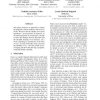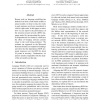ACL
2015
8 years 7 months ago
2015
This paper proposes an approach to capture the pragmatic context needed to infer irony in tweets. We aim to test the validity of two main hypotheses: (1) the presence of negations...
ACL
2015
8 years 7 months ago
2015
Given a set of basic binary features, we propose a new L1 norm SVM based feature selection method that explicitly selects the features in their polynomial or tree kernel spaces. T...
ACL
2015
8 years 7 months ago
2015
We explore using relevant tweets of a given news article to help sentence compression for generating compressive news highlights. We extend an unsupervised dependency-tree based s...
ACL
2015
8 years 7 months ago
2015
Text regression has traditionally been tackled using linear models. Here we present a non-linear method based on a deep convolutional neural network. We show that despite having m...
ACL
2015
8 years 7 months ago
2015
Syntactic annotation is a hard task, but it can be made easier by allowing annotators flexibility to leave aspects of a sentence underspecified. Unfortunately, partial annotatio...
ACL
2015
8 years 7 months ago
2015
Recent work on language modelling has shifted focus from count-based models to neural models. In these works, the words in each sentence are always considered in a left-to-right o...
ACL
2015
8 years 7 months ago
2015
Given a discourse tree for a text as a candidate answer to a compound query, we propose a rule system for valid and invalid occurrence of the query keywords in this tree. To be a ...
ACL
2015
8 years 7 months ago
2015
Using natural language to write programs is a touchstone problem for computational linguistics. We present an approach that learns to map natural-language descriptions of simple �...
ACL
2015
8 years 7 months ago
2015
Multi-modal semantics has relied on feature norms or raw image data for perceptual input. In this paper we examine grounding semantic representations in olfactory (smell) data, th...
ACL
2015
8 years 7 months ago
2015
This paper presents the NL2KR platform to build systems that can translate text to different formal languages. It is freelyavailable1, customizable, and comes with an Interactive ...


